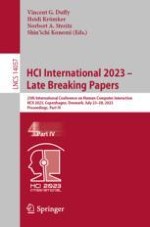This seven-volume set LNCS 14054-14060 constitutes the proceedings of the 25th International Conference, HCI International 2023, in Copenhagen, Denmark, in July 2023.
For the HCCII 2023 proceedings, a total of 1578 papers and 396 posters was carefully reviewed and selected from 7472 submissions. Additionally, 267 papers and 133 posters are included in the volumes of the proceedings published after the conference, as “Late Breaking Work”.
These papers were organized in the following topical sections: HCI Design and User Experience; Cognitive Engineering and Augmented Cognition; Cultural Issues in Design; Technologies for the Aging Population; Accessibility and Design for All; Designing for Health and Wellbeing; Information Design, Visualization, Decision-making and Collaboration; Social Media, Creative Industries and Cultural Digital Experiences; Digital Human Modeling, Ergonomics and Safety; HCI in Automated Vehicles and Intelligent Transportation; Sustainable Green Smart Cities and Smart Industry; eXtended Reality Interactions; Gaming and Gamification Experiences; Interacting with Artificial Intelligence; Security, Privacy, Trust and Ethics; Learning Technologies and Learning Experiences; eCommerce, Digital Marketing and eFinance.
